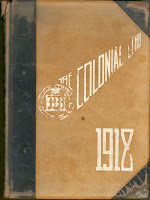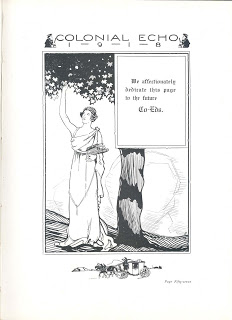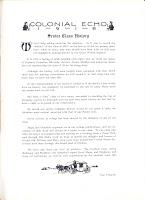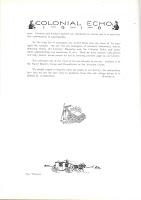The May 8, 1918, edition of the Flat Hat provided a brief summary of the April 19th meeting of the Board of Visitors on its front page including continuing preparations for the arrival of the College of William and Mary's first female students in the fall. Meanwhile, the newspaper's second page (incorrectly dated March 8, 1918) included a plea over two columns entitled "Urged to Stay in College." The presence of the article offers further illustration of William and Mary's precarious enrollment as numbers declined due to the ongoing conflict of war, personal economics, and other reasons.
For additional information about the first women students at the College of William and Mary see: When Mary Entered with her Brother William: Women at the College of William and Mary, 1918-1945 by Laura F. Parrish; "The Petticoat Invasion": Women at the College of William and Mary, 1918-1945; The Martha Barksdale Papers; and the Women at the College of William and Mary page on the Special Collections Research Center Wiki.
May 8, 2008
May 6, 2008
May 1918: The Colonial Echo on Coeds
 As the class of 1918 prepared to graduate from William and Mary, there were some mixed messages from the student body about their feelings of being the last all male class at the College in the yearbook, the Colonial Echo.
As the class of 1918 prepared to graduate from William and Mary, there were some mixed messages from the student body about their feelings of being the last all male class at the College in the yearbook, the Colonial Echo.
At the end of the senior class history on page 36 of the yearbook, the class historian remarked on the “melancholy fact that we are the last class to graduate from this old college before it is defiled by co-education.” While this may imply the historian’s dismay with the College becoming co-educational, twenty-one pages later on page 57 the Colonial Echo “affectionately dedicates this page to the future Co-Eds.”
This yearbook is an excellent example of the conflicting opinions about co-education at William and Mary in the months leading up to the first twenty female students’ arrival in September 1918. As previous entries about Flat Hat opinion articles have shown, there was a small, but vocal, contingent against co-education, which is represented in the yearbook by the historian’s parting line in the class history. At William and Mary, there were also quite a few students and faculty who were either indifferent or supported the arrival of women.
Click to enlarge the senior class history:


For more information on co-education’s reception on campus, as well as other questions, please contact the Special Collections Research Center, Swem Library, College of William and Mary.
This post was composed by Jordan Ecker.
For additional information about the first women students at the College of William and Mary see: When Mary Entered with her Brother William: Women at the College of William and Mary, 1918-1945 by Laura F. Parrish; "The Petticoat Invasion": Women at the College of William and Mary, 1918-1945; The Martha Barksdale Papers; and the Women at the College of William and Mary page on the Special Collections Research Center Wiki.
April 24, 2008
April 24, 1918 - Last Student Editorial Against Co-education
While the Strode Bill had been passed a month earlier, some students at the College were not willing to let women in. On April 24, 1918, an opinion piece ran on the front page of the Flat Hat entitled "Sine Qua Non," by "A Student." In it, "A Student" explained what a tragedy it was that the College was going to lose its "traditions." At the end of the article, the author suggested to his fellow students to stop co-education by dissuading the young, college aged women in their lives from attending William and Mary in the fall.
As history tells us, this young man's plot failed to keep co-education from the College, and in September, twenty women did enter as part of the class of 1922. Interestingly, this is the last of the Flat Hat articles decrying co-education. This illustrates that compared to other institutions that went co-ed in the first half of the twentieth century, William and Mary students and faculty were rather accepting of the idea of co-education. For example, a college about the size of William and Mary, Drew University in Madison, New Jersey, went co-ed in the fall of 1942. The students at Drew were outraged, as their student newspaper, The Acorn, indicates in April, 1942. The entire front page of that April issue was consumed by the headline "Drew Goes Co-Ed," followed by an article, which attempted to placate an assumed outraged student body by stating that the "girls" who will only be at the college during World War II, will not be allowed to live in the dormitories on campus and will be kicked out once the men come back from the war. This type of strong reaction against co-education is actually quite normal for most colleges in the twentieth century. Reaction against co-education prevented universities and colleges, such as Harvard and Bowdoin College in Brunswick, Maine; from going co-ed until the 1970s.
So, while some at William and Mary may have had adverse reactions to the idea of women enrolling in the college and meddling with "tradition," these sentiments were rather tame and in the minority compared to other colleges and universities across the country as they thought about and became co-educational.
Additional information about the history of Drew University is available from the Drew University Archives.
For additional information about the first women students at the College of William and Mary see: When Mary Entered with her Brother William: Women at the College of William and Mary, 1918-1945 by Laura F. Parrish; "The Petticoat Invasion": Women at the College of William and Mary, 1918-1945; The Martha Barksdale Papers; and the Women at the College of William and Mary page on the Special Collections Research Center Wiki.
As history tells us, this young man's plot failed to keep co-education from the College, and in September, twenty women did enter as part of the class of 1922. Interestingly, this is the last of the Flat Hat articles decrying co-education. This illustrates that compared to other institutions that went co-ed in the first half of the twentieth century, William and Mary students and faculty were rather accepting of the idea of co-education. For example, a college about the size of William and Mary, Drew University in Madison, New Jersey, went co-ed in the fall of 1942. The students at Drew were outraged, as their student newspaper, The Acorn, indicates in April, 1942. The entire front page of that April issue was consumed by the headline "Drew Goes Co-Ed," followed by an article, which attempted to placate an assumed outraged student body by stating that the "girls" who will only be at the college during World War II, will not be allowed to live in the dormitories on campus and will be kicked out once the men come back from the war. This type of strong reaction against co-education is actually quite normal for most colleges in the twentieth century. Reaction against co-education prevented universities and colleges, such as Harvard and Bowdoin College in Brunswick, Maine; from going co-ed until the 1970s.
So, while some at William and Mary may have had adverse reactions to the idea of women enrolling in the college and meddling with "tradition," these sentiments were rather tame and in the minority compared to other colleges and universities across the country as they thought about and became co-educational.
Additional information about the history of Drew University is available from the Drew University Archives.
For additional information about the first women students at the College of William and Mary see: When Mary Entered with her Brother William: Women at the College of William and Mary, 1918-1945 by Laura F. Parrish; "The Petticoat Invasion": Women at the College of William and Mary, 1918-1945; The Martha Barksdale Papers; and the Women at the College of William and Mary page on the Special Collections Research Center Wiki.
April 19, 2008
April 19, 1918: News from the Board of Visitors Meeting
 The meeting of the Board of Visitors of the College of William and Mary on April 19, 1918, included the typical business of the group related to College infrastructure, faculty, and students. Among the new positions the BOV authorized President Lyon G. Tyler to hire was a Dean of Women who would be paid $2,000 annually-the same amount as the proposed new professor of Chemistry and $400 more than the proposed associate professor of Modern Languages. Click to enlarge.
The meeting of the Board of Visitors of the College of William and Mary on April 19, 1918, included the typical business of the group related to College infrastructure, faculty, and students. Among the new positions the BOV authorized President Lyon G. Tyler to hire was a Dean of Women who would be paid $2,000 annually-the same amount as the proposed new professor of Chemistry and $400 more than the proposed associate professor of Modern Languages. Click to enlarge. The BOV also authorized President Tyler and a member of the faculty to visit women's colleges on fact-finding trips to learn more about the education of women and report back to the BOV at their next meeting in June. Click to enlarge.
The BOV also authorized President Tyler and a member of the faculty to visit women's colleges on fact-finding trips to learn more about the education of women and report back to the BOV at their next meeting in June. Click to enlarge.For additional information about the first women students at the College of William and Mary see: When Mary Entered with her Brother William: Women at the College of William and Mary, 1918-1945 by Laura F. Parrish; "The Petticoat Invasion": Women at the College of William and Mary, 1918-1945; The Martha Barksdale Papers; and the Women at the College of William and Mary page on the Special Collections Research Center Wiki.
March 15, 2008
March 15, 1918: Strode Bill Approved
Just a quick post to note that the Strode Bill making coeducation at the College of William and Mary official was approved on March 15, 1918.
The bill's sponsor, Senator Aubrey E. Strode of Amherst, Virginia, may be better known for drafting Virginia's Eugenical Sterilization Act (1924), which he later argued in favor of before the U.S. Supreme Court as Buck v. Bell (1927). Strode's support for coeducation, which began in 1910 with his proposal of a bill to bring a coordinate college (a women's college) to the University of Virginia continued as he supported coeducation at VPI after William and Mary brought women to campus. To learn more about coeducation at VPI (Virginia Tech), including Strode's role, see Access and Inclusion: Women Students at VPI, 1914-1964 and for more information about coeducation at the University of Virginia, see Breaking and Making Tradition: Women at the University of Virginia.
For additional information about the first women students at the College of William and Mary see: When Mary Entered with her Brother William: Women at the College of William and Mary, 1918-1945 by Laura F. Parrish; "The Petticoat Invasion": Women at the College of William and Mary, 1918-1945; The Martha Barksdale Papers; and the Women at the College of William and Mary page on the Special Collections Research Center Wiki.
The bill's sponsor, Senator Aubrey E. Strode of Amherst, Virginia, may be better known for drafting Virginia's Eugenical Sterilization Act (1924), which he later argued in favor of before the U.S. Supreme Court as Buck v. Bell (1927). Strode's support for coeducation, which began in 1910 with his proposal of a bill to bring a coordinate college (a women's college) to the University of Virginia continued as he supported coeducation at VPI after William and Mary brought women to campus. To learn more about coeducation at VPI (Virginia Tech), including Strode's role, see Access and Inclusion: Women Students at VPI, 1914-1964 and for more information about coeducation at the University of Virginia, see Breaking and Making Tradition: Women at the University of Virginia.
For additional information about the first women students at the College of William and Mary see: When Mary Entered with her Brother William: Women at the College of William and Mary, 1918-1945 by Laura F. Parrish; "The Petticoat Invasion": Women at the College of William and Mary, 1918-1945; The Martha Barksdale Papers; and the Women at the College of William and Mary page on the Special Collections Research Center Wiki.
March 13, 2008
March 13, 1918: The Flat Hat
The Flat Hat article of March 13, 1918, about coeducation at the College of William and Mary, which appeared after the House of Delegates had voted in favor of the Strode Bill, was a bit more optimistic than the article of February 27 (there was no mention in the newspaper's March 6 or 10 issues). The article stressed how the college would benefit from coeducation, with larger appropriations from the General Assembly for more buildings, including "new dormitories, another dining hall, and a new and more commodious gym." The newspaper anticipated the "new social element" that the presence of women would bring to William and Mary and predicted that the "bonds of tradition would be broken" with coeducation. No longer would things have to be done merely because "that's the way it's always been done," and the participation of women in activities would "rejuvenate them with better standards."
For additional information about the first women students at the College of William and Mary see: When Mary Entered with her Brother William: Women at the College of William and Mary, 1918-1945 by Laura F. Parrish; "The Petticoat Invasion": Women at the College of William and Mary, 1918-1945; The Martha Barksdale Papers; and the Women at the College of William and Mary page on the Special Collections Research Center Wiki.
For additional information about the first women students at the College of William and Mary see: When Mary Entered with her Brother William: Women at the College of William and Mary, 1918-1945 by Laura F. Parrish; "The Petticoat Invasion": Women at the College of William and Mary, 1918-1945; The Martha Barksdale Papers; and the Women at the College of William and Mary page on the Special Collections Research Center Wiki.
February 27, 2008
Feburary 27, 1918: The Flat Hat
To again quote from Laura Parrish's M.A. thesis When Mary Entered with Her Brother William: Women Students at the College of William and Mary, 1918-1945:
The Strode bill had passed the Virginia Senate by a vote of 19 to 13. The necessary physical plant improvements at the College included expanding certain departments (more faculty) and adding more dormitories and in the short-term completing the remodeling of existing dorms to accommodate "such a new addition to our student body." The Flat Hat's editors seem to have accepted the eventuality of coeducation at their College by this date.
For additional information about the first women students at the College of William and Mary see: When Mary Entered with her Brother William: Women at the College of William and Mary, 1918-1945 by Laura F. Parrish; "The Petticoat Invasion": Women at the College of William and Mary, 1918-1945; The Martha Barksdale Papers; and the Women at the College of William and Mary page on the Special Collections Research Center Wiki.
The Flat Hat, the student newspaper and chief forum of student opinion at the College of William and Mary, did not comment on the Strode Bill until after it had passed the Senate. On February 27, the paper discussed the effects of coeducation in negative terms. It saw the necessary enlargement of the physical plant and of the faculty as being of questionable value and as a step that would not "help our tradition in the least." The article, or editorial as it may have been, suggested making another college coeducational or upgrading one of the women's normal schools. It concluded with the hopes that if coeducation became a reality, the students would "make the best of it," and "that our environment--socially and in every other way [would] be benefited by coeducation."
The Strode bill had passed the Virginia Senate by a vote of 19 to 13. The necessary physical plant improvements at the College included expanding certain departments (more faculty) and adding more dormitories and in the short-term completing the remodeling of existing dorms to accommodate "such a new addition to our student body." The Flat Hat's editors seem to have accepted the eventuality of coeducation at their College by this date.
For additional information about the first women students at the College of William and Mary see: When Mary Entered with her Brother William: Women at the College of William and Mary, 1918-1945 by Laura F. Parrish; "The Petticoat Invasion": Women at the College of William and Mary, 1918-1945; The Martha Barksdale Papers; and the Women at the College of William and Mary page on the Special Collections Research Center Wiki.
Subscribe to:
Posts (Atom)


